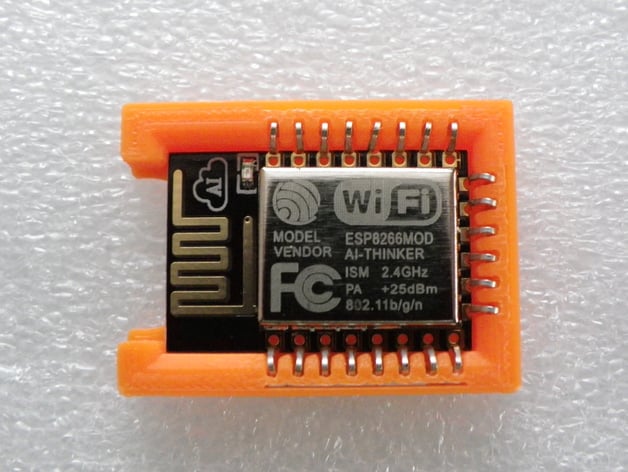
Customisable Module Socket for ESP8266 HC-05 etc
thingiverse
I've designed a customizable socket that can fit any module you want to program, such as the ESP8266 Wi-Fi module or an HC-05 Bluetooth module. The open SCAD file assumes that the left and right sides are mirrored and that if there are pins along the top, they will be mirrored to the bottom. I sourced pins from a bag of different IC sockets, broke them apart to recover the pins, straightened their legs, and found that through-hole sockets worked better even though I intended for the socket to be surface-mounted. In the end, I used pins from an 84-pin PLCC socket (search for "PLCC IC Socket") with a 2.54mm / 0.1 inch pin spacing and through-hole pins. The open SCAD file can generate SVG files with the outline of the socket, holes needed, and copper pad placement. This allows you to create custom parts for your favorite PCB design software. The Open SCAD file also generates a baseboard to cover any offset pins, both functions are experimental so don't rely on the default settings in the file. I think that some pins might need to be built in three parts, let me know what you think. Print Settings: - Printer: CTC Creator - Rafts: No - Supports: No - Resolution: 0.1mm - Infill: 100% Notes: I've printed these in both PLA and ABS, the socket came out better in ABS but the text was more readable in PLA, there's not a massive difference either. Custom Section: Instructions: First, source the pins you intend to use as you'll need to measure them for the customizer. I found a PLCC socket with through-hole pins worked best due to their longer legs. Once you have your pins, straighten the legs, measure them, and put them aside. See pictures. I used information from the PLCC socket's data sheet along with physical measurements to get the information needed for the customizer. From the data sheet of your module; add the width and height of the board, I found a 0.2mm margin worked fine otherwise the board is too tight in the socket. PAD_WIDTH: On the module when the pads meet the edge of the board, that's the PAD_WIDTH (see pictures). Pin settings: See picture above for pin dimensions. Text is any short label you wish to print into the socket, leave it blank if you don't want anything. I found this worked better in PLA than in ABS. Stud_Depth: If creating an SMD version by bending legs out to the side of the socket, you might want small studs for placing the socket while soldering. Also, longer studs can be passed through the PCB and melted to stop the socket from pulling away from the board, helping anchor the body of the socket. Set it to 0 if you don't want studs on the socket. Once you've printed the body of the socket, I drilled holes for the pins as they were too fine for my machine. In order to insert the pins, poke the leg of the pin through the hole first and then apply a little heat from a soldering iron to push it into place along with a little pressure to push the pin towards the back of its recess. This melts and seals the hole for the leg as well as starting to melt the pin in the back of the recess so that it grips the pin better. After printing, I didn't use the base; instead, I used epoxy to secure the socket onto the PCB then soldered the pins to the board.
With this file you will be able to print Customisable Module Socket for ESP8266 HC-05 etc with your 3D printer. Click on the button and save the file on your computer to work, edit or customize your design. You can also find more 3D designs for printers on Customisable Module Socket for ESP8266 HC-05 etc.
